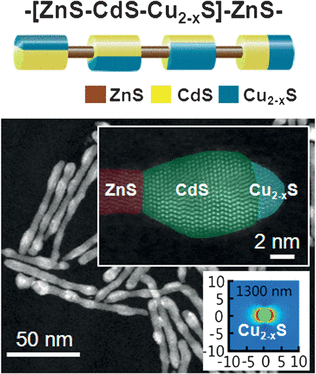Nanocrystals expand the range of solar cell light energy to ultraviolet and infrared regions

Common solar cells made of crystalline silicon can only access roughly half of the total sunlight spectrum for conversion of light energy into electricity. Searching for more effective materials, Chinese scientists have now combined three semiconducting sulfide crystals to a ternary nanostructured photovoltaic system that absorbs irradiation from ultraviolet to near infrared regions. As they report in the journal Angewandte Chemie, the nanorods effectively convert the full-spectrum light energy into electric current. This discovery marks a new level in the development of more efficient solar cells.
The photovoltaic material that is most commonly used today is crystalline silicon, but it absorbs sunlight effectively only in the visible region. Other semiconducting materials cover slightly different regions of the solar spectrum, but the most efficient photovoltaic materials would be clearly those that include every region from the ultraviolet to the infrared. Shu-Hong Yu and Jun Jiang and their collaborators at the University of Science and Technology of China in Hefei have now introduced a nanostructured system made of three sulfide crystals. The ternary hybrid material of zinc, cadmium, and copper sulfides effectively absorbs the ultraviolet, visible, and near infrared light, and the segmented node-sheath structure of the tiny rods provides the ideal energy band alignment for an effective accumulation of charge carriers.
The basis of this photocollecting system is nanosized rods of zinc sulfide on which crystalline sheaths of cadmium sulfide are deposited like an arrangement of pearls. The zinc sulfide basis provides the UV absorption, while the cadmium sulfide covers the visible light region. As a third component for IR absorption, the scientists chose copper sulfide nanocrystals with copper deficiencies, as this material is known to feature a special type of absorption in the near-infrared region called surface plasmon resonance. "These heteronanorods absorb across nearly the full spectrum of solar energy," the scientists report.
To test the functionality of the nanorods, the scientists measured their performance in a photoelectrochemical water-splitting cell. Upon full-spectrum illumination, the photocurrent response was pronounced, which was a first experimental evidence for the successful design of their photovoltaic material. One of the crucial achievements of this work, however, was the correct adjusting of the sensitive heterojunctions that connect the different semiconducting structures to align the energy gaps of the semiconducting materials. "Such a staggered alignment enables the separation of the photogenerated electrons and holes in the ternary hybrid nanostructure," say the authors. Although further experiments have to be performed, this ternary semiconducting system can be regarded as an important step toward a new generation of efficient solar cells covering the rainbow colors and beyond.
More information: Tao-Tao Zhuang et al. Integration of Semiconducting Sulfides for Full-Spectrum Solar Energy Absorption and Efficient Charge Separation, Angewandte Chemie International Edition (2016). DOI: 10.1002/anie.201601865
Journal information: Angewandte Chemie , Angewandte Chemie International Edition
Provided by Wiley




















